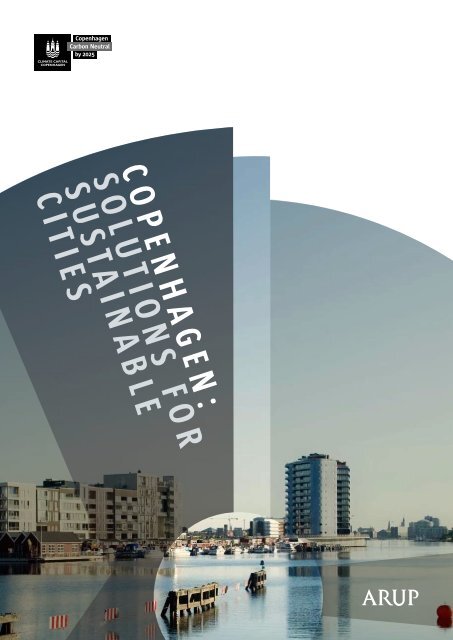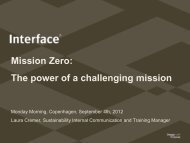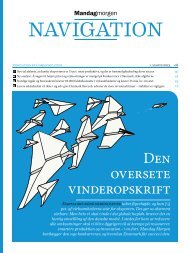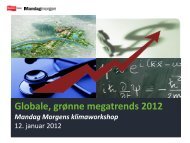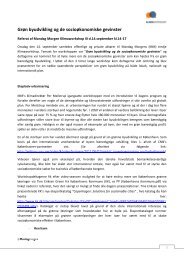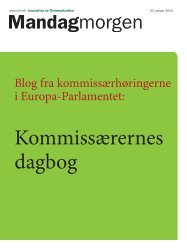Copenhagen: Solutions for Sustainable Cities - Arup
Copenhagen: Solutions for Sustainable Cities - Arup
Copenhagen: Solutions for Sustainable Cities - Arup
- No tags were found...
You also want an ePaper? Increase the reach of your titles
YUMPU automatically turns print PDFs into web optimized ePapers that Google loves.
<strong>Copenhagen</strong>:SOLUTIONS FORSUSTAINABLECITIES
The <strong>for</strong>mer fish market in the South Harbour is trans<strong>for</strong>med into a Dutch inspired canal town / Credit: Rishi, Happy Living
Mayor’s IntroductionLord Mayor Frank Jensen / Credit: Jacob Carlsen
Harbour BathsTHEHARBOURTURNSBLUESummer life at one of <strong>Copenhagen</strong>’s three Harbour Baths / Credit: Kontraframe
<strong>Copenhagen</strong>: <strong>Solutions</strong> For <strong>Sustainable</strong> <strong>Cities</strong>08/09Environmental• Reduced risk of urban flooding polluting the harbourthrough better stormwater management• More and diverse flora and fauna is returning to thearea.• The water quality in the harbour continues to improveyear after year• Green roofs also relieve urban heat stress andimprove insulation of buildings, and so help us toreach our carbon reduction targets.• Residents used to drive 10km to a beach, now theycan walk or cycle to the Harbour Baths.1000m 31600120080040001996 2000 2009Sewage and rain water discharged into the Portof <strong>Copenhagen</strong>Turning the tide in yourharbour//What sort of circumstances might other cities be facingthat would make <strong>Copenhagen</strong>’s experience of the harbourproject relevant?• A partly or fully de-industrialised harbour• A sewage system in need of upgrade• A climate that enables outdoor swimminga possibility.Swimming 5 minutes away from the central city / Credit: Casper Dalhoff, BIG+JDS
WaterOur solution in more detail//• Created an evidence base: detailed mapping ofsediments below city, construction of models of ahydrological cycle around the city, and a detailedgroundwater model and 3D mapping down to depthsof 300m have enabled better management of waterresources.• Used In<strong>for</strong>mation Technology to reduce waste: A newSMART system management allows better regulationof water pressure.• Increased water efficiency – an investment in theminimisation of water loss in the city’s infrastructurethrough leak detection technology, regulation ofwater pressure and other mitigation measures. Waterlosses in pipelines are as high as 40 to 50% in somecities, whereas the figure <strong>for</strong> <strong>Copenhagen</strong> is nownearer 6 to 7%.• Managed rainwater more efficiently: rainwater run-offis stored locally and more slowly let into the sewerswhen capacity allows it. Four types of system areemployed:- evaporation: e.g. green roofs,• Financial incentives: encourage businesses andcitizens to reduce run-off into the city foul sewernetwork with up to 3,000 Euros available to residents<strong>for</strong> collecting and reusing rainwater, and consumercharges of 5 euros per cubic metre of water to reducewasteful use of drinking water.• Awareness raising campaigns: reduce individualconsumption, with a target to cut consumption percapita from 110 litres per day to 100 litres per day.(From a high of 170 litres/day/person in 1987).180160140120100100Target numberof litres of waterused per day,per <strong>Copenhagen</strong>citizen.26%Average watersavings 6 yearsafter installingindividual watermeter.- recycling: water storage and local reuse <strong>for</strong> gardenwatering, clothes washing, toilet flushing- percolation: slow seepage into grounde.g. permeable paving198719901995 2000 2005 2010Water consumption in <strong>Copenhagen</strong> 1987-2010, litres/person/day- delay: Balancing ponds, paved areas that store waterand move it around be<strong>for</strong>e discharging into sewagesystem.- Purification: A variety of filtration and separationmethods, e.g. sand trap and basins, oil separators,filters and advanced treatment.• Separate systems <strong>for</strong> rainwater and rainwater runoff /storm water are required to be integrated into all newdevelopments.
<strong>Copenhagen</strong>: <strong>Solutions</strong> For <strong>Sustainable</strong> <strong>Cities</strong>The benefits of innovation//• Environmental: water losses reduced to 6 to 7%;energy consumption from water services reducedand long-term need <strong>for</strong> energy intensive solutionslike desalination avoided; no chemical treatment ofdrinking water, and a low demand <strong>for</strong> bottled water.• Social: new recreational areas created from diversionof stormwater; strong engagement with citizens totake individual action in the best interest of the city asa whole.Saving every drop inyour city//What sort of circumstances might other cities be facingthat would make <strong>Copenhagen</strong>’s experience of saving thecity’s water relevant?• Shortage of clean water supplies• High level of water loss from potable water system• Risk of rainwater flooding.12/13• Economic: reduced long term costs through:- Lower energy use,- Less frequent need to fully replace existing pipenetwork- Better monitoring and repair- Lower risk of rainwater floodinglocal businesses achieve reduced production coststhrough greater water efficiency.One of the many joys of water / Credit: Thorkild Christensen
CyclingThe fastest way of getting around in <strong>Copenhagen</strong> is by bike / Credit: Mikal SchlosserCYCLING:THE FASTWAYFORWARD
<strong>Copenhagen</strong>: <strong>Solutions</strong> For <strong>Sustainable</strong> <strong>Cities</strong>16/17More than half of the people living in <strong>Copenhagen</strong> use their bike every day / Credit: Troels Heien, Monoline
TransportTRANSPORT:THE GREENLIGHTThe <strong>Copenhagen</strong> Metro has been awarded best in the world / Credit: Jakob Boserup
<strong>Copenhagen</strong>: <strong>Solutions</strong> For <strong>Sustainable</strong> <strong>Cities</strong>Giving integrated publictransport the green light18/19« Like many other cities, economic growth in <strong>Copenhagen</strong> hasbrought with it increased traffic congestion. However, byinvesting in an efficient, reliable and highly integrated publictransport network, IT HAS been possible to deliver some ofthe highest levels of mobility in the world. alongside traffic,congestion and pollution HAVE BEEN REDUCED to levels thatare extremely low by the standards of major internationalcitIES. The number of car trips WITHIN the central part of<strong>Copenhagen</strong> fell from 351,000 in 1970 to 284,900 in 2010. »The challenge of the car//Without a decent alternative, people who can af<strong>for</strong>d a carwill drive it. Between 1970 and 2010 the number of dailycar trips across the municipality border rose from 392,000to 535,700 and across the whole of Denmark there has beenan increase in cars from 408,000 to 2 million between 1961and 2010. The Co 2emissions from road transport rose alongwith the increased traffic to around 500,000 tonnes in 2005.Without concerted action <strong>Copenhagen</strong> could have facedthe traffic congestion and pollution problems that haveblighted many other cities.Integration - our solution//Our solution was to developphysical and virtual (in<strong>for</strong>mationtechnology) integration betweenbus, train and the metro servicesto enable passengers to moveseamlessly between different modes.Attempts to convince people to use public transport werehindered by:• A massive improvement in travel time <strong>for</strong> car-trafficdue to investments in road-infrastructure• Unreliable and inconvenient public transport due tolack of investments in infrastructure• Relocating work places away from the inner city torural and suburban areas - often far from train stationsand with high accessibility <strong>for</strong> cars• Lack of integration between transport systems andoperators• Inflexibility of funding mechanisms to create newservicesAn integrated transport system between bus, train & metro.
TransportOur solution in more detail//• Integrated ticketing: one ticket is valid on bus, trainand metro across all 3 public transport operators.Transfer between each mode is free.• SMS ticketing: novel use of in<strong>for</strong>mation technologyenables passengers to simply text where they are andwhere they’re going to, and receive a text reply whichserves as their travel ticket. This speeds up journeytimes, reduces queuing and cuts operational costs.60% of tickets <strong>for</strong> one journey are now bought bySMS and it is expected that paper based tickets willbe entirely replaced within a few years.• The <strong>for</strong>mation of a special purpose company unitingthe train, Metro, bus and telephone companies hasenabled SMS to be easily adopted by customers, asfares are paid through telephone bills.• Development of an online Journey Planner - an easyway to plan your journey from A to B across all thedifferent transport modes.The benefits of integratedtransport//• Environmental: by improving the integration of thesystem there has been an increase in the proportionof total trips made by public transport and a fall inprivate car usage. For every person using the Metroinstead of travelling alone by car, carbon dioxideemissions drop by 83%.• SOCIAL: the ability to change more easily betweenmodes, and <strong>for</strong> cycling to be better adapted withthe public transport system has enabled faster,safer, healthier and less stressful journeys. Peopleuse public transport and cycling because it is thefastest, cheapest and most convenient way to travel,contributing to <strong>Copenhagen</strong>’s reputation as one of themost livable cities in the world.• Economic: a successful integrated public transportsystem and reduced congestion make <strong>Copenhagen</strong>a good place to do business, with fast and reliablejourney times <strong>for</strong> both passengers and freight.60%The percentageof people paying<strong>for</strong> publictransport in thecity by SMS.• Bus stops are integrated into Metro stops and otherpublic transport facilities to enable easy transfers.• Bus priority signaling systems: using radio and GPStechnology enables traffic controllers to keep lightsgreen if buses are approaching and have broughtimproved accessibility and speed <strong>for</strong> buses.• Fully integrated Real Time In<strong>for</strong>mation is providedto the public by traffic control, which can be viewedonline or from mobile devices.• Legislation was introduced to stop competitive publictransport operators charging different prices.integrated transportIN YOUR CITY//What sort of circumstances might other cities be facingthat would make <strong>Copenhagen</strong>’s experience of integratedtransport relevant?• High demand <strong>for</strong> travel• Concern about traffic congestion• Multiple public transport operators• Mayoral ownership and/or strong regulatory controlof key transport systems to enable their development• Significant cycle parking facilities have beenintroduced in each metro and train station and cyclesare permitted to be taken on the trains themselves.
<strong>Copenhagen</strong>: <strong>Solutions</strong> For <strong>Sustainable</strong> <strong>Cities</strong>Our solution in more detail//• Treating waste as a resource- setting a fixed price <strong>for</strong> recyclables collection- volume based charges <strong>for</strong> residual waste- experimentation with collection of plastic at ahousehold level.• National regulation means that waste sent to landfillincurs a tax of US$10/tonne, while waste sent toincineration incurs a tax of US$8.50/tonne.• It is now illegal in Denmark to send combustible wasteto landfill, when it could be incinerated.• Focusing on changing public attitudes by supplyingin<strong>for</strong>mation on recycling and linking waste andclimate change.• Improving possibilities <strong>for</strong> reuse and recyclingincluding easy and logical source separation• Ensuring the generation of heat from waste is acentral energy supply to the city’s district heatingscheme.• A pilot plant <strong>for</strong> the treatment of 800kg/hour ofunsorted household waste has been developedas part of the REnescience project. The plant wascommissioned in December 2009 and separates theorganic and inorganic fractions in the <strong>for</strong>m of biogasor bioethanol. These bio fuels can be used <strong>for</strong> theproduction of power and heat in accordance withmarket demand. Metals and glass are separatedfrom the inorganic fraction of the waste <strong>for</strong>recycling. REnescience is a cooperation betweenDong Energy and the local waste incineration plantAmager<strong>for</strong>brænding.• Maturing and upscaling of the REnesciencetechnology, including design, construction andoperation of larger waste refineries is being planned.• A suggested liberalisation will set pricing free andintroduce competition <strong>for</strong> waste.The benefits of an integratedwaste managementapproach//• Environmental: Reduced Co 2emissions through:- improved reuse and recycling- combined heat and power generation feeding thedistrict heating network- centrally located waste facilities- advanced organic waste treatment.• Social: The public now perceives waste as a resourceto provide heat and power to homes and businessesand so they comply with the waste managementsystem to process their waste in the most efficient andpractical manner.• Economic: waste is now treated as a resource,avoiding millions of euros of landfill taxes fromthe European Union, providing energy security andsuppressing a rise in residential and business energybills at a time of rising fossil fuel prices.Recycling waste in your city//What sort of circumstances might other cities be facingthat would make <strong>Copenhagen</strong>’s experience of recyclingwaste relevant?• Significant waste volumes• The ability to regulate or influence some or allparts of the waste management system: collection,separation, or treatment• Capacity, or potential capacity, to use heat orelectricity generated from waste.35.0to n n e s56.7to n n e s77.4to n n e s94.6to n n e sCoalFuel oilNatural gasWasteincinerationCo 2emissions from energy production, tonnes C0 2/GJ22/23
Wind PowerTHE FORCEOF PUBLICSUPPORTFOR WINDPOWER« Despite unexceptional wind resources, 22% of Denmark’stotal electrical consumption is produced from windturbines, the highest rate in the world*. In <strong>Copenhagen</strong>a renewable energy infrastructure has been introducedthrough a unique partnership based on local ownership. »*based on 2005 figures.The <strong>Copenhagen</strong> wind turbines at Middelgrunden are owned by citizens / Credit: Rishi, Happy Living
<strong>Copenhagen</strong>: <strong>Solutions</strong> For <strong>Sustainable</strong> <strong>Cities</strong>THE FORCE OF PUBLICSUPPORT FOR WIND POWER24/25The challenges to wind//Like every city, <strong>Copenhagen</strong> faces challenges to windpower:• Limited space to implement wind energy on a largescale within an urban environment.• Wind turbines are expensive to build.• Public resistance to the perceived visual and noiseimpact of wind turbines in the landscape.18h o u r sThe time takento construct twowind turbines.The solution -local ownership//Our solution was to encouragepopular support <strong>for</strong> wind-power bycreating a community-owned facility,and USING local skills.Our solution in detail//• Community Ownership – the first wind farm atMiddelgrunden, created a Wind Turbine Cooperativehalf-owned by the city owned utility company, withhalf the shares sold to 8,650 members of the localcommunity. Each of the shares represents productionof 1000 kWh/year and was sold <strong>for</strong> 4,250 DKK(US$809).• Public Awareness Campaign – demonstration toursof on-shore wind turbines helped convince locals thatthere would be no noise impact from the project.• Highly efficient technical construction –specially designed foundations were developed tocope with the ice during severe winters. Optimisationof factors such as tidal movements, wave resistance,ice loads, fatigue strength and robust submarinecables were also incorporated.• Grid rein<strong>for</strong>cement – the ability of the power gridto accept and balance increased levels of intermittentenergy from wind turbines.• Lessons learned from each successful wind farmare used to in<strong>for</strong>m subsequent schemes, highlightinghow replicable the model is.• Nationally set targets – the Danish Government setan aim to turn 50% of Danish electricity productioninto wind power by 2030, such targets driverenewable energy innovation.
Wind Power• Based on the <strong>Copenhagen</strong> Climate Plan, the cityowned utility company plans to build more than100 new wind turbines be<strong>for</strong>e 2025. Locally basedcooperatives will be able to invest in the turbines.• The main part of the new turbines will be basedoutside <strong>Copenhagen</strong>, either land based or sea based.However, a decision to build some of the turbines in<strong>Copenhagen</strong> has been politically approved.• A recent survey among the citizens of <strong>Copenhagen</strong>indicates wide spread popular support <strong>for</strong> windturbines in the city.2005 2006 2007 2008Revenue per full time employeeExport per full time employeeRevenue and export of the windmill-sector (US$)$447,483$354,609THE BENEFITS OF WIND POWER//• Environmental: Significant contribution toachieving carbon reduction goals: <strong>for</strong> example,energy production at the Middelgrunden wind farm isestimated to be 89 million kWh of electricity annually.The project eliminates 258 tonnes of sulphur dioxideemissions, 231 tonnes of nitrogen oxide emissions,76,000 tonnes of carbon dioxide emissions and 4,900tonnes of dust and clink every year.• Social: Community engagement in delivery ofclimate change objectives. Jobs were created. Thewind industry employs more than 25,000 people inDenmark.• Economic:– The City of <strong>Copenhagen</strong> made a profit out of the saleof its’ first successful wind farm. Revenue has nowbeen recycled back into city projects.– Green Economy – through creating strong localdemand, the Danish wind turbine industry has growninto a multi-billion dollar industry, achieving growthrates of over 30% per year, with over 350 companiesproducing turbine towers, blades, generators,gear boxes and control systems. Almost half theworld’s wind turbines are now produced by Danishmanufacturers.– Low running costs – Wind turbines have low runningcosts following initial investment and expenditure.21,008Employment in the windmill sector28,4002005 2006 2007 2008 2009 2010The right climate <strong>for</strong> wind//What sort of circumstances might other cities be facingthat would make <strong>Copenhagen</strong>’s experience of communityownedwind power relevant?• Average wind speeds of at least 5 metres per second– usually seen as the minimum <strong>for</strong> wind power to becommercially viable.• Mayoral power to create or support a communityownedsolution.25,000
<strong>Copenhagen</strong>: <strong>Solutions</strong> For <strong>Sustainable</strong> <strong>Cities</strong>Below: Reduced Co 2emissions and produced windmillenergy in <strong>Copenhagen</strong> 2001-201026/27332,862to n n e s3,503,811gj432,569apa rtm e n t sReduced Co 2emissionsProduction ofwind energy in<strong>Copenhagen</strong>Number ofapartments theelectricity canpower <strong>for</strong> oneyearWind turbines are an integrated part of the <strong>Copenhagen</strong> skyline / Credit: Rishi, Happy Living
HeatingKEEPINGTHE CITYWARMEFFICIENTLY98 per cent of households are connected to the district heating grid/ Credit: Becky
<strong>Copenhagen</strong>: <strong>Solutions</strong> For <strong>Sustainable</strong> <strong>Cities</strong>Keeping the city warm efficiently« Our district heating system is among the world’s largestand most successful. It supplies 98% of the city and 500,000inhabitants with reliable and af<strong>for</strong>dable heating. Districtheating is one of the most carbon efficient ways to produceand supply energy locally, cutting out much of the wasteassociated with centralized power generation. By integratingrenewable fuels such as biomass to replace fossil fuels in thesystem, further emissions reductions have been achieved. »28/29The challenge of RISINGENERGY PRICES//The district heating system was first established in the mid1920s, but it was more intensively developed as a way toprotect citizens and the economy from the dramatic rise infossil fuel prices in the 1970s - a time when the city faced:• Over dependency on increasingly scarce and expensivefossil fuels• Air quality concerns caused by coal burning within acity environment• Low efficiency of energy distribution in existing districtheating networkour solution//The solution was to reduce thecity’s reliance on fossil fuels bymaximising energy generated fromwaste.Technologies such as Combined Heat and Power(CHP) to capture and re-use heat energy that isotherwise lost in the electricity generation process.Our district heating network distributes this heatenergy efficiently around the city. The integration ofrenewable fuels, such as biomass, further reduces thecarbon intensity of the network.98%The percentageof <strong>Copenhagen</strong>served by theDistrict HeatingSystem.
HeatingOur solution in detail//Development of a district heating system that uses heatgenerated from waste-to-energy plants; along with CHPtechnology, initially fuelled by coal, natural gas, and oil.Step-by-Step expansion of the network – district heatingdoes not necessarily require an overhaul of existing energysystems. It can be implemented over a significant periodof time. A steam network was originally established tosupply hospitals and industry, and once a steam pipewas established, offices, institution and dwelling housesnearby were also connected.Regular rehabilitation of the system over time to maintainan efficient network and provide the best value toresidential and business customers.De-carbonising the district heating system:• Renewable energy supply: The use of mixed fuel, suchas natural gas, oil, straw and wood pellets in CHPunits allows the highly efficient use of the energy inthe fuels (up to 94%), and so results in lower carbondioxide emissions. Biomass is planned to replacecoal and provide 100% renewable energy from theCHP plants, one plant has been converted to 100%biomass and the conversion of 3 additional plants isplanned.• Developing technology to burn straw with optimumfire protection.• The goal of the city is in the short term to convert allremaining coal-fired CHP to biomass.• As a long term strategy the City of <strong>Copenhagen</strong> isnow testing the use of geothermal energy in thedistrict heating network.• Nitrogen oxide, sulphur dioxide and fly ash areremoved from the flue gases be<strong>for</strong>e being releasedinto the atmosphere and used to produce high qualityby-products such as gypsum, concrete blocks andinsulating material.• Optimise the operational efficiencies of the network,such as seasonal reductions to the temperature of theheat supply - low temperature district heating.There are also plans to have biogas as an operationalpart of the town gas grid as a result of extracting gas fromsludge waste water treatment processes.The benefits of districtheating//Environmental:• The District Heating system achieves lower carbondioxide emissions than the individual gas (40% lower)and oil (50% lower) boilers it replaced.• Overall carbon dioxide emissions resulting from theconsumption of heat and electricity have droppedfrom 3,460,000 tonnes in 1995 to 2,541,000 tonnes in2005.• Cogeneration of heat and electricity useapproximately 30% less fuel to produce the sameamount of heat and power in separate heat andpower plants.• Around 40% of the waste incinerated from the cityis turned into electricity and heat. Combined withan extensive programme of waste management,prevention, separation and recycling, only 1.8% ofwaste in <strong>Copenhagen</strong> is deposited in landfills.• Conversion to biomass fuelled district heating isfurther decarbonising the energy supply.Social:• 750 jobs were created in developing the gridinfrastructure required <strong>for</strong> the district heating system.Economic• With high fuel efficiencies of up to 94% bysimultaneously generating heat and power the powerplants need much less fuel per kWh generated. Incomparison, conventional power plants have anefficiency as low as 30-40%.• District heating costs around 45% less than oilheating and approximately 56% less than natural gas<strong>for</strong> a home of 130m 2 and an average consumptionof 18 MWh/year (based on 2009 figures). Districtheating is there<strong>for</strong>e considered price competitive <strong>for</strong>household consumers.• District heating can be a competitive solution in newurban development areas, compared to alternativeslike individual solar heating or individual heat pumps.100%Level ofrenewableenergy nowprovidedthrough biomassinstead of coalat the AmagerCHP plant.60,000to n n e sReduction ofCo 2emissionsthrough wasteincineration.
<strong>Copenhagen</strong>: <strong>Solutions</strong> For <strong>Sustainable</strong> <strong>Cities</strong>Why switch onto district heating?//30/31What sort of circumstances might other cities be facing that would make<strong>Copenhagen</strong>’s experience of district heating relevant?• High heat demand in a concentrated area• Ability to co-locate centralised (low carbon) generation capacity close todemand• District heating network in need of modernization / optimisation, extensionand / or decarbonisation.23%6% 7%39%Renewable wasteNon-renewable wastePelletsStrawCoalFuel oil and gasoilNatural Gas5%11%10%Fuel sources <strong>for</strong> the districtheating network120,00060,000Supply of heat and electricity fromthe incineration of waste (number ofhouseholds)HeatElectricity
CoolingKeeping cool underCo 2pressure« The increased demand <strong>for</strong> air conditioning and coolinghas led to higher electricity consumption in many cities. Inour ef<strong>for</strong>t to provide low carbon cooling, we’ve built thefirst two district cooling networks. They are based on freecooling from SEA WATER ABSTRACTION, along with runningsurplus heat from the district heating network, throughabsorption cooling AND traditional compression chillers.The project is expected to save us 14,000 tonNEs of carbondioxide per year. »The challenge we faced//Peak summer temperatures in <strong>Copenhagen</strong> can hit as highas 35°C and are expected to rise by 2 to 3% by 2050 - withaverage daily temperatures also rising. And so the demand<strong>for</strong> traditional air conditioning is increasing. The problemsare:• Traditional air conditioning systems/compressor basedchillers are expensive.• Traditional cooling systems are noisy and utilise a lotof space.• Dependency on electricity based cooling appliancescould create unsustainable electricity demand andover reliance on fossil fuels.• There is currently excess surplus heat within thedistrict heating system during summer months whendemand is low.HOW WE MET THE CHALLENGE//Our solution was to developa ‘District Cooling’ system tocomplement the highly successfulDistrict Heating system. DistrictCooling is the centralisedproduction and distribution ofchilled water. It is distributed viaunderground insulated pipelines tocommercial and industrial buildingsto cool the indoor air.
<strong>Copenhagen</strong>: <strong>Solutions</strong> For <strong>Sustainable</strong> <strong>Cities</strong>32/33KEEPINGCOOLunder C02pressureCredit: Rishi, Happy Living
CoolingOur solution in more detail//• Identification of co-located buildings - with coolingrequirements to ensure there was an adequatedemand <strong>for</strong> a district cooling network.• Building a new cooling station – with a capacityof 15MW and utilizing a combination of existingresources: seawater from the Port of <strong>Copenhagen</strong> inperiods where the seawater is sufficiently cold, andsurplus heat from the district heating network duringperiods of low heat demand.• Cooling: our solution – the use of excess heat fromthe district heating system during the summermonths (this also helps balance the district heatingsystem)• Integration of different principles of cooling – theplant was designed around three different methodsof cooling making it very flexible and highly energyefficient,depending on the temperature of theseawater:- Free Cooling – Seawater temperature is below 5.5degrees Celsius and cooling demand low (less than2400 kW). All cooling demands are covered by freecooling heat exchangers.- Combined operation – Seawater temperature isbetween 5.5 o C and 11.5 o C. Heat exchangers are used<strong>for</strong> pre-cooling of the cooled water, be<strong>for</strong>e it is fullycooled by chillers to the desired temperature.- Chiller cooling – Seawater temperature is above11.5 o C. The seawater is too warm to be used <strong>for</strong>free cooling so absorption and compression chillersprovide all cooling. Free cooling heat exchanges arebypassed completely.The benefits of our newcooling system//• Environmental:- Carbon dioxide reduction of 67%, compared totraditional cooling. The annual sulphur dioxide andnitrogen oxide savings are 62% and 69% respectively.- Potential to negate or, at least, reduce the urbanheat island effect .- Demand <strong>for</strong> electricity is reduced becauseelectrically operated chillers are replaced by freecooling and heat operated chillers and DistrictCooling.- Excess heat, noise and chemicals from or usedin compressions chillers are avoided in individualbuildings.• Social:- Zero noise, in contrast to conventional coolingmethods- Removes many of the health risks associated withcooling towers e.g. Legionnaire’s disease.- Increased energy security from a centralised supplywith improved resilience built in.- Back up provision available.• Economic:- Reduction in expenditure <strong>for</strong> energy imports.- Cooling contracts with different organisationsand institutions can be replicable, allowing easytransferability.- Free up commercial, retail and parking spaces asconventional cooling systems and fan coils on roofsare replaced by underground infrastructure.• Created multiple connections to a network – DistrictCooling works on the same principles as districtheating. Chilled water is produced centrally andcarried to the end customers through a systemof pipes. Networks can be built adjoining districtheating pipework, or can be laid where no existingnetwork is in place.• Commercial development of network - are based onprofitable business cases.
<strong>Copenhagen</strong>: <strong>Solutions</strong> For <strong>Sustainable</strong> <strong>Cities</strong>The conditions <strong>for</strong> changingair conditioning//• Client demand - a customer base is a keyrequirement. Organisations with existing coolingsystems of more than 150kW are likely to beinterested in district cooling, as it becomes bothfinancially feasible and attractive. A sufficientsupply of customers in the vicinity of a plant isrequired to maximise the plant’s total coolingcapacity.• Suitable mix of buildings <strong>for</strong> developing network– the district cooling network can be retrofittedin existing buildings (often overcoming issues ofexternal units in the historic urban landscape), aswell as being incorporated into new buildings.• Available Coolth - a source of either surplus heat,e.g. from CHP or cooling provided by seawater.• Legal framework – the District Cooling Act 2008allows municipalities that fully or partly owndistrict heating companies to create and rundistrict cooling networks.70%Reduction of Co 2emissions.80%Reductionof electricityconsumption.Effects of district cooling compared to traditionalcooling methods.Does notinfluence thearchitecturalimpression ofthe city.34/35The district cooling system distributes chilled water to cool the indoor air of buildings
Come And See UsWe hope you were as inspired by our sustainable solutionsas we often are by other cities and their solutions.The City of <strong>Copenhagen</strong> is pleased to provide morein<strong>for</strong>mation about the solutions.More in<strong>for</strong>mation is available at: www.kk.dk/englishincluding photo-downloads <strong>for</strong> the press.Please mail remaining questions regarding the solutions,processes and their results to:copenhagensolutions@okf.kk.dk
<strong>Copenhagen</strong>: <strong>Solutions</strong> For <strong>Sustainable</strong> <strong>Cities</strong>36/37COME ANDSEE US
Partners<strong>Copenhagen</strong> CleantechCluster (CCC)<strong>Copenhagen</strong> Cleantech Cluster (CCC) is the largest cluster organisationin Denmark and acts as the one-stop entry to Danish cleantech. Basedon Denmark’s long tradition in the field of cleantech technologiesand renewable energy, CCC is among the leading and most renownedcleantech clusters in the world, creating superior value <strong>for</strong> companies,research institutions and public authorities by tying cleantechtechnologies and communities together across sectors, value chains andborders.A unique group of partners are behind <strong>Copenhagen</strong> Cleantech Cluster,including a large number of companies like Vestas, Novozymes, DongEnergy and universities like Risø DTU, DTU, and the University of<strong>Copenhagen</strong>.EnergyToursOffers high-level delegations of commercial decision makers, technicians,politicians and journalists a unique opportunity to come and experienceDanish cleantech and climate solutions. EnergyTours will create aprogram consisting of site visits and business meetings tailored to yourcurrent needs and challenges, helping you solve the problems of thefuture. Furthermore, EnergyTours offers to take care of all the logistics –from local transportation to accommodation and translation. ExperienceDanish technology live!Web: www.energytours.dkEmail: contact@energytours.dkTel. +45 7210 0179Further in<strong>for</strong>mation: www.cphcleantech.comContact: info@cphcleantech.comTel: +45 3322 0222Climate Consortium DenmarkA public-private partnership set up in June 2008 to strengtheninternational awareness of Danish competencies and solutions in theareas of energy, climate adaptation and environment. As the officialfocal point <strong>for</strong> all business-related cleantech activities in Denmark, theConsortium works to promote solutions <strong>for</strong> sustainable growth locallyand globally. The Consortium is owned by the Branding Denmark Fund,the Confederation of Danish Industry, the Danish Energy Association,the Danish Agriculture & Food Council and the Danish Wind IndustryAssociation.Web: www.climateconsortium.comEmail: info@climateconsortium.comTel.: +45 7210 0179Ministry of Foreign Affairs ofDenmark - The Trade CouncilThrough the Ministry of Foreign Affairs’ Embassies, Consulates Generaland Trade Commissions, the Trade Council is present in all significantexport markets throughout the world. The Trade Council’s global networkof 250 advisers with local expertise stands ready to serve Danish tradeand industry. The Trade Council, advises Danish companies on export,internationalization, and innovation as well as <strong>for</strong>eign companiesconsidering establishing in Denmark.Web: www.eksportraadet.um.dkEmail: eksportraadet@um.dkTel.: +45 33 92 05 00
<strong>Copenhagen</strong>: <strong>Solutions</strong> For <strong>Sustainable</strong> <strong>Cities</strong>Foreningen afRådgivende IngeniørerFRIFRI (the Danish Association ofConsulting Engineers)Danish Water Forum - Your gatewayto water knowledge!38/39A trade association of Danish consulting firms providing consultingservices, planning and project management on a technical-scientificbasis. In addition, member firms provide services in economic as well asnon-technical fields with delivery of the relevant systems involved.Total turnover in the industry amounts to DKK 11 bn (€1,5 bn) inDenmark.Danish Water Forum is a network of Danish water organizations aimingat highlighting Danish water expertise and knowledge and facilitatingconcerted actions. The competencies and high standards of its membersmake DWF an excellent entry point to the Danish water sector and itsservices within all aspects of water industry, technology, science andmanagement. DWF represents:FRI’s member firms provide independent consulting services on marketterms. FRI represents the majority of businesses in the industry. FRI’smember firms employ about 12,000 people in Denmark and over 9,000abroad.••••Contractors and manufacturersWater companies and consultantsResearch institutionsGovernment authorities and NGOsWeb: www.frinet.dk/fri/englishEmail: fri@frinet.dkTel.: +45 35 25 37 37DWF is open to all Danish organizations within water and related sectorssuch as environment, agriculture, and health.Web: www.danishwater<strong>for</strong>um.dkEmail: dwf@danishwater<strong>for</strong>um.dkTel.: +45 4516 9038Danish IndustriThe confederation of Danish Industry (DI) is a private organisationcurrently funded, owned and managed entirely by 10.000 companieswithin manufacturing, trade and service industry. DI member companiesconstantly develop more efficient cleantech products and services andoffers today environmental friendly solutions to most of the global climatechallenges world wide. DI is strategic partner in various internationalcleantech partnerships including <strong>Copenhagen</strong> Cleantech Cluster.HarryTechnical Consultants13 Fitzroy StreetLondon, W1T 4BQ+44 [0] 20 7636 1531Issue Marketing20 Hanson StreetLondon, W1W6UF+44 [0] 777 589 1006www.arup.comwww.harrybarlow.com
<strong>Copenhagen</strong>: <strong>Solutions</strong> For <strong>Sustainable</strong> <strong>Cities</strong>CITY OF COPENHAGENCity Hall1599 København V–copenhagensolutions@okf.kk.dkwww.kk.dk/english


